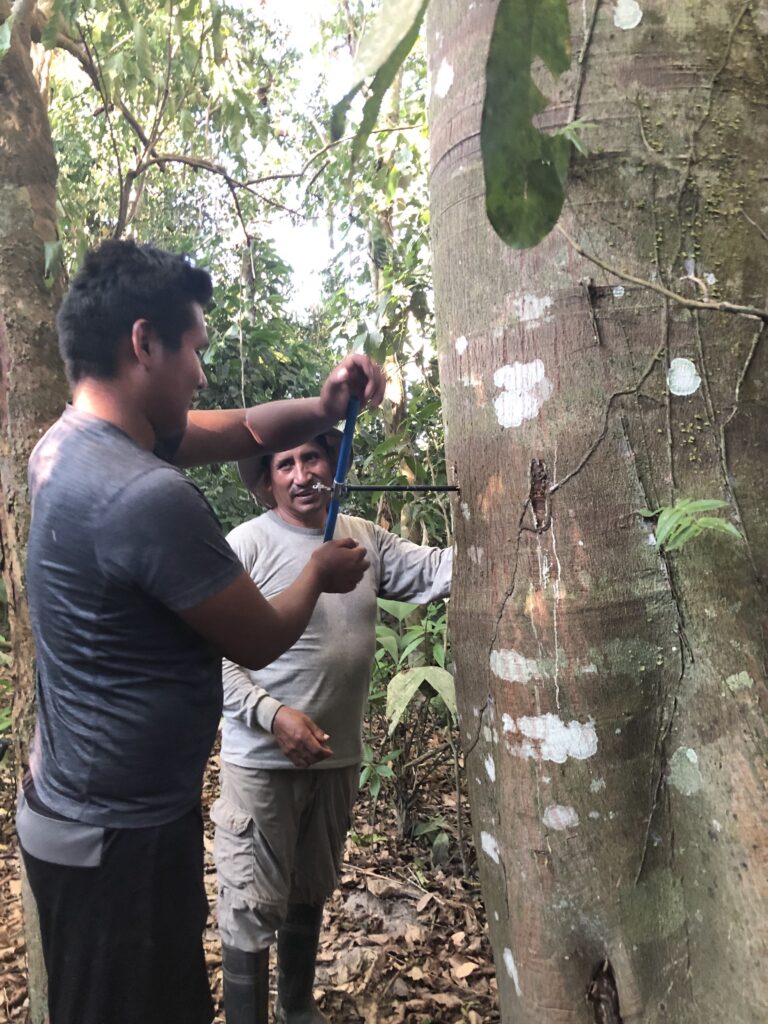In the depths of the Amazon rainforest, trees may be quietly recording one of the region’s most persistent environmental threats: mercury pollution from gold mining.
A new study in Frontiers in Environmental Science shows, for the first time, that tropical trees can store a historical record of mercury exposure in their growth rings. The research was led by Cornell University’s Jacqueline Gerson and co-authored by Sabin Center Fellows Luis E. Fernandez and Claudia Vega.
“The Trees are Telling Us Something”
Using tree core samples collected from forests near artisanal and small-scale gold mining (ASGM) sites in the Peruvian Amazon, the team measured mercury concentrations across annual growth rings. Tree rings reflected spatial differences in mercury exposure across all sites, but showed clear temporal trends only at the areas most heavily impacted by gold mining.
“Tropical trees can act as living archives. If we can read their rings, we can reconstruct how mercury pollution has evolved in these landscapes—information that’s critical for restoration, policy, and protecting communities.”
Sabin Center Senior Fellow Luis Fernandez
“The trees are telling us something,” said Gerson. “In places that are now highly contaminated near mining, tree rings reflect how mercury exposure in the forest has changed over time. This gives us a powerful new tool to study contamination where no long-term monitoring exists and to determine approximately when this increase in mercury concentration began.”

Mercury is a highly toxic metal still commonly used in small-scale gold mining to extract gold from ore—using primitive methods similar to those employed during the California Gold Rush over 175 years ago. Once released, this mercury can contaminate air, water, and soil—and accumulate in fish consumed by wildlife and local communities. In regions like the Peruvian Amazon, this poses serious risks to both ecosystems and human health. Yet long-term monitoring data are often unavailable due to the remoteness of many mining sites.
Sounding the Alarm For Years
Fernandez and Vega have been sounding the alarm on these dangers for years. Fernandez, a research professor in Wake Forest’s Department of Biology, is also executive director of the Amazonian Center for Scientific Innovation (CINCIA), which he co-founded in 2016. Vega, recently named a 2025 TED Fellow for her work on mercury pollution in the Amazon, is CINCIA’s mercury research coordinator and helped lead field data collection in Madre de Dios.
“Tree rings don’t just tell us about pollution—they help us understand the long-term risks communities may have faced without even knowing it,” said Vega. “Mercury is highly toxic, and once it’s released, it can move through ecosystems and food chains.”
Knowing where and when exposure has occurred is critical for protecting both the forest and the people who depend on it.
Sabin Center Fellow Claudia Vega
This is the first empirical study to demonstrate that tropical trees can serve as biomonitors of mercury pollution in areas impacted by ASGM. The research team sees this method as a promising tool for tracking environmental change across the Amazon and other gold-mining frontiers globally.
Banner Photo Credit: Jason Houston
